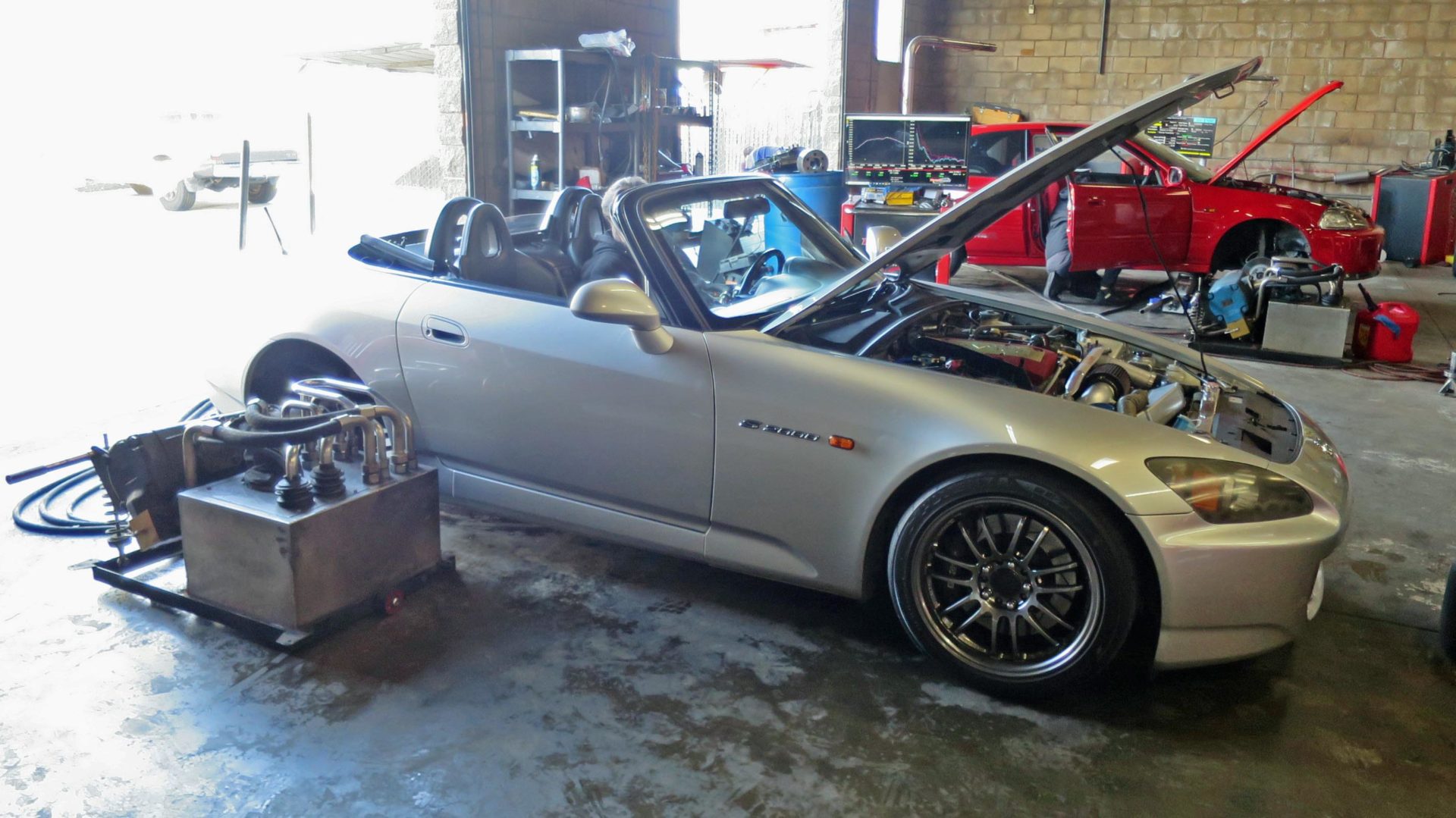 Now with high confidence that everything was operating properly, it was back to the dyno.
Now with high confidence that everything was operating properly, it was back to the dyno.
 A benefit of using an air-to-water intercooler system is there’s a ton of thermal mass due to the density and specific heat capacity of the coolant to keep intake air temps relatively stable. With an air-to-air intercooler, you only have the thermal mass of the aluminum of the intercooler. The downside to the air-to-water system is that you have a lot more failure modes, the extra mass to haul around, and extra heat transfer inefficiency. Instead of transferring heat from the charge air (air out of the turbo compressor) to the ambient air directly like the air-to-air intercooler, it has to go charge air to coolant to ambient air. For a street car, air-to-water works great for doing short bursts with time to cool down in between. For sustained high-power boost, like in a track car, air-to-air is the way to go. Um, back to my point, the intake air temperatures were very stable and consistent now and Church was able to push 14psi of boost at redline compared to the prior 13psi with the hot intake air temperatures.
A benefit of using an air-to-water intercooler system is there’s a ton of thermal mass due to the density and specific heat capacity of the coolant to keep intake air temps relatively stable. With an air-to-air intercooler, you only have the thermal mass of the aluminum of the intercooler. The downside to the air-to-water system is that you have a lot more failure modes, the extra mass to haul around, and extra heat transfer inefficiency. Instead of transferring heat from the charge air (air out of the turbo compressor) to the ambient air directly like the air-to-air intercooler, it has to go charge air to coolant to ambient air. For a street car, air-to-water works great for doing short bursts with time to cool down in between. For sustained high-power boost, like in a track car, air-to-air is the way to go. Um, back to my point, the intake air temperatures were very stable and consistent now and Church was able to push 14psi of boost at redline compared to the prior 13psi with the hot intake air temperatures.
 The 4th gear pull on the dyno took about 13 seconds and the intake air temperatures went from ~83degF to 97degF at the end of the run (the light grey line). The ambient air temperature was about 72degF. This plot is from the datalog from the Hondata KPro.
The 4th gear pull on the dyno took about 13 seconds and the intake air temperatures went from ~83degF to 97degF at the end of the run (the light grey line). The ambient air temperature was about 72degF. This plot is from the datalog from the Hondata KPro.

For an air-to-air intercooler setup reference, this is data from AMS Performance on the stock intercoolers of the Porsche 991.1 911 Turbo and the AMS Alpha Intercooler upgrades. The stock intercoolers have a massive temperature rise over a 10-second pull on the dyno. My air-to-water setup had a temperature rise of ~14degF and a total temperature of ~25degF over ambient. The stock Porsche 991.1 911 Turbo setup was a massive ~85degF over ambient. The AMS Alpha Intercooler upgrade ended up ~40degF over ambient; I tossed out their run #2 which seemed to be an outlier with the excessively higher start temperature compared to all of the other runs starting ~20degF over ambient. You can see how the extra thermal mass of an air-to-water setup is a huge benefit for a short pull. As I said though, for sustained use such as on a road course, the air-to-air will typically outperform the air-to-water.
 This is how much oil was collected by the Killer B Motorsport Air Oil Separator from the dyno session and a bit of hard driving by a buddy in town visiting over the holidays.
This is how much oil was collected by the Killer B Motorsport Air Oil Separator from the dyno session and a bit of hard driving by a buddy in town visiting over the holidays.
 Using the dyno data and datalog of the dyno pull from the Hondata KPro, I was able to calculate these values of the engine and turbo performance. I did guesstimate the pressure drop of the air filter and intercooler using reasonable values from other vehicles. I typically like to do all my calculations in SI units, but everyone in the US is more familiar with Imperial, so please excuse the mixing of units.
Using the dyno data and datalog of the dyno pull from the Hondata KPro, I was able to calculate these values of the engine and turbo performance. I did guesstimate the pressure drop of the air filter and intercooler using reasonable values from other vehicles. I typically like to do all my calculations in SI units, but everyone in the US is more familiar with Imperial, so please excuse the mixing of units.




16 comments
Epic build! Always love your updates. Your attention to detail and penchant for data is an inspiration. Looking forward to hearing how the “quickspool” effects things.
On a side note, I must say that I would love to see this thing with a full OE style valved* exhaust. Big pipes and cats, but giant mufflers and electronically controlled cutout! It would cost a human soul to do right but man that would just be the cherry on top of an already incredible build!
I was confused for a bit on the boost curve shape until the mention of constant duty cycle came up – I may be spoiled by having worked with stuff natively designed for turbos and forgot that PID isn’t a given. Interesting results and gratifying even from here to see what it can do, I imagine it’s far moreso on your side of the screen.
Flat torque from 3500 rpm to 8000 rpm in an f20c proves your diligence in designing the turbo system was worth the effort. great read!!!
What I’d really like to see is this with G30-660 or 770, 0.83 A/R, on a track setup with wastegate dump and bigger exhaust. it should really flow well on the top-end.
The G30 series makes me go sploosh. Once I’m done with my current turbo (Boostlab) I’ll look at the g series.
Agreed but for a street car, making that much torque that low AND being quiet is nice.
Can’t wait to read about it!!!
With the extra manifold, maybe consider consulting with Artec Performance and see if they could work with the design? I’d love to see your manifold become more readily available (or might have to shoot you an email about it)
Incredible build otherwise!
I could always sell the design I guess! The car has been a big long science project and it’s been a lot of fun.
It’s been a blast to watch it all come together I’ve been following it for years! Hoping to see an update with E85 added in one day
I would love to see the design sold and other people trying different setups with it!
Thought about testing the 0.92 A/R housing on the current setup and switching to a less restrictive exhaust ? That combined with some quickspool should wake up both the mid-range and top end. I’ve run up to 90% quickspool duty with larger turbos using the Honda-based ECU code. With this smaller turbo, you probably don’t need that much though. Try using quickspool pressure equal to wastegate pressure if targetting more than WG pressure or 1-2 psi under wastegate to prevent boost spikes.
Some tuners map in quickspool in the WG duty table and don’t use the pre-set Hondata feature. This allows you to tailor quickspool to different target pressures (boost per gear for example)
I’d go to G30-660 in 0.83AR before the G25-660 with 0.92. That G30 config would spool faster and make more power I think. I’m happy with the exhaust volume noise as it is, so no changing it. I’ve had some time to adjust the boost by gear and the settings for the quick boost. I’ll update in the next article but your recommendation of targeting around WG pressure is accurate. If you look at the screen shot of the boost settings in this article, you’ll see the targets are higher than achievable in the lower rpm range which is the alternative strategy you mentioned. I’m not sure if I like the quick spool yet, I need to get out in the canyons and see what the throttle/boost/torque modulation is like in the twisties.
Are you just set on keeping the stock axle back exhaust section or would you consider making a nice system and perhaps including a resonator or two to keep things quiet and streetable without producing so much back pressure?
I’m set on it to keep the stock/stealth appearance. I’ve been driving it a couple times a week and I honestly leave it on low boost/wastegate most of the time as most of my driving is on surface streets. I can still give it full throttle without spinning in second gear once the tires are warmed up.
Hello Khiem, i do have some questions related with an article you did back in 2012. Can you kindly email me?
Thx,
Rafael,
Spain
Awesome project. LHT Performance did a similar build and they did a custom twin exit exhaust where side is opened via vacuum/boost for sufficient flow under larger boost settings, yet still quiet like stock-ish under normal throttle low speed etc. Check it out on youtube. Can’t wait for the next iteration!
Yup, I catch their videos here and there. I’m impressed they got the internally gated turbo to fit, though they did have to compromise on the manifold design a bit. I figure a freer flowing rear exhaust section with larger diameter pipes and straight-thru mufflers would free up 20-30hp on this setup. And still be pretty quiet.